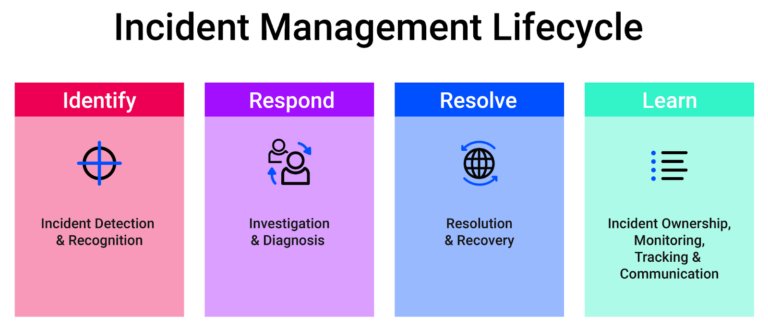
Incident management can mean many things, depending on your work. For example, it can describe an organisation’s activities to identify, analyse, and correct hazards. In many ways, this definition’s identification, analysis, and correction element is valid for most incident management use cases, whatever the description of “incident”.
This blog, however, is about the IT service management (ITSM) use of incident management, where an incident is considered any event that disrupts or could disrupt a service. While ITIL 4, a body of service management best practice guidance, describes the purpose of the incident management practice as: “…to minimise the negative impact of incidents by restoring normal service operation as quickly as possible”.
Most organisations have some form of incident management, even if they call it something else – for example, ticket management. But, whatever your organisation calls the handling and resolution of IT issues, how good are your IT support capabilities and what improvements could be made to improve the IT operations and business outcomes? To help, this blog looks at the common challenges with incident management practices and offers ten tips for improving IT support capabilities.

The Common Barriers to Incident Management Success
There are some basic root causes to consider when looking at the potential issues with incident management. These root causes can be regarded as foundational rather than operational (although they adversely impact operations) and include:
- Ad hoc IT support operations with limited structure and process repeatability
- Insufficient personnel.
- The absence of enabling technology – whether for ticket handling or diagnostics and incident resolution.
- No agreed service targets and performance measures.
More root causes could be added to this list, but the point is to understand that some issues or barriers are “table stakes” for effective incident management – where the application of this blog’s and other tips will be suboptimal if the foundational elements aren’t in place. It wasn’t deliberate, but the above root causes fit the “people, processes, and technology” mantra that ITIL has long communicated.
The common incident management barriers can also be operationally related, for example:
- Lack of training (in incident management processes, tool use, engagement, problem-solving, etc.)
- Communication issues
- Poorly defined roles and responsibilities
- No learning and the absence of knowledge management
- Poor incident prioritisation
- The lack of integration with other ITIL capabilities, such as problem management and change enablement
- No continual improvement.
All of these barriers could be flipped to create incident management improvement tips.

10 Tips for Better Incident Management
The possible tips for incident management can cover a broad spectrum of areas – from getting the basics right through to the evolution of IT support strategies to better focus on business needs. So while ten tips are shared in this blog, many more could be made. Plus, of course, not every tip is relevant for every organisation. It might be that, out of the ten tips below, only three are relevant to yours. But please take a look and use whatever helps:
- Agree on the purpose of your incident management (and broader IT support) capabilities. This tip might seem obvious, but consider this: are your IT support capabilities about fixing IT issues or getting employees productive again? There’s a big difference between the two objectives that will impact IT support strategies, measures, and improvements.
- Ensure a suitable incident management “foundation” exists across people, processes, and technology. Issues with any of these elements will ultimately adversely affect the effectiveness of incident management. For example, long waits caused by insufficient personnel will increase employee lost productivity, especially when employees simply struggle with their IT issues rather than seeking help.
- Make success metrics about business and not just IT success. The IT industry has its traditional IT support metrics, but it’s important to appreciate that these often focus on the mechanics of incident management – measuring “how many” and “how quickly” – rather than the perceived outcomes of end-users and other business stakeholders. In addition to having the right portfolio of performance metrics, ensure that reporting and analytics capabilities add value rather than simply being churned out every month with little interest and inaction.
- Set the incident prioritisation matrix and associated service-level targets in line with business needs and expectations. Don’t simply adopt priority-level industry best practices because this might not suit your organisation’s requirements.
- Train incident management personnel in everything they need, not just the processes, ITSM tools, and technologies they’ll support. For example, they must also understand the business context of IT issues and hone their softer skills to facilitate engagement. And don’t forget to factor in regular training refreshers and updates.
- Educate end-users on how to get the most from corporate IT support capabilities. This education can include when different access channels work best (and how to use them) and facilitate the management of end-user expectations.
- Leverage technology wherever possible – from the traditional workflow and automation capabilities found in ITSM tools, through self-service, to newer artificial intelligence (AI)-enabled capabilities that – if used correctly – should facilitate “better, faster, cheaper” IT operations and business outcomes. Be careful, though, because while technology can deliver significant incident management benefits, your organisation must ensure that efficiency isn’t improved at the expense of effectiveness.
- Make improvement part of business as usual (BAU). This improvement focus can relate to incident management operations, or it can relate to the handling of specific issues. For example, a repeat incident might necessitate a workaround until a proper root-cause resolution is found and actioned.
- Ensure that improvements are business, not IT support, focused. It’s another obvious point to make. However, it’s essential to ensure that improvements focus on “what matters most” to business rather than IT stakeholders and that any improvements to IT operations don’t adversely impact business operations and outcomes. For example, saving a pound per incident ticket might seem like a significant IT support win. Still, the business-level reality might be that the resultant end-user lost productivity far outweighs the IT gain.
- Never stop learning. This tip can cover various areas. For example, related to new incident management practices, new technologies, better fixes for common issues, post-incident reviews after major incidents, or learning more from other IT teams.
HaloITSM helps you improve the efficiency of your incident management through centralised workflows to track and manage incidents throughout their lifecycle. Using HaloITSM, you can identify recurring incidents, spot trends, and make data-driven decisions for process improvements. But don’t just take our word for it – click the button below to schedule a demo and see it for yourself!



